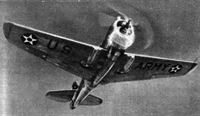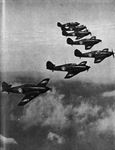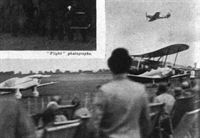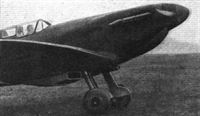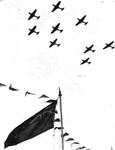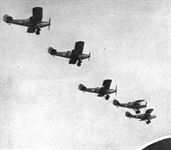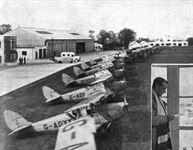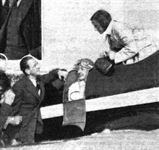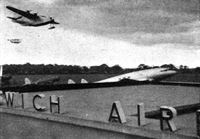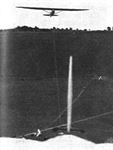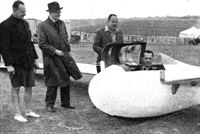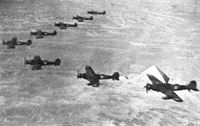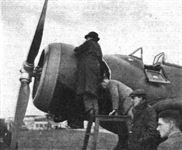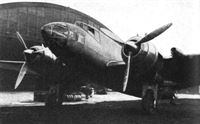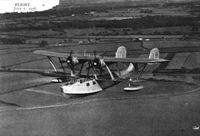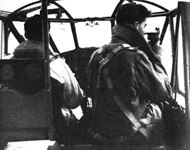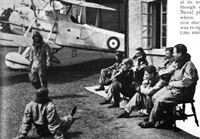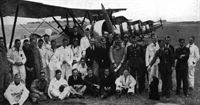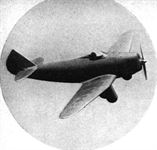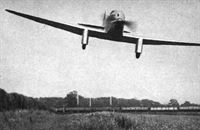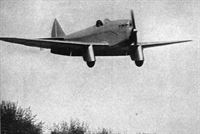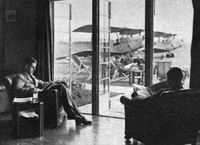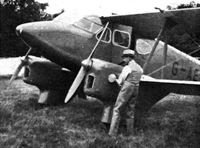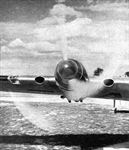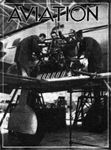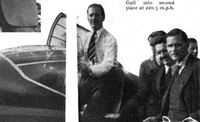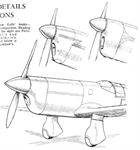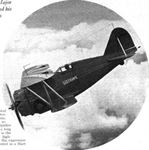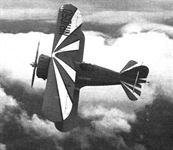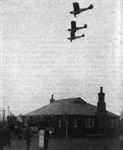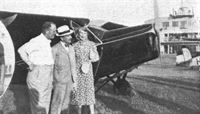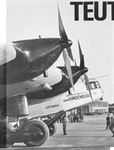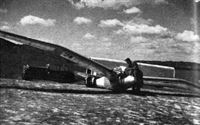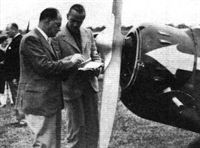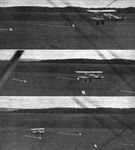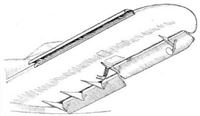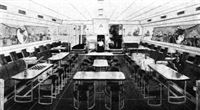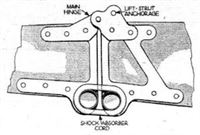Фотографии
-
Регистрационный номер: K7208 An example of the nose radiator position. The Whitley IV has Rolls-Royce Merlin IV engines.
Самолёты на фотографии: Armstrong Whitworth Whitley / A.W.38 - Великобритания - 1936
-
COMMERCIAL CURTISS: A new thirty-passenger monoplane is being built by the Curtiss Company, who presumably have had enough of seeing Douglas and Lockheed have everything their own way. This sketch shows the lay-out, particularly the fine shape of the fuselage.
Самолёты на фотографии: Curtiss-Wright C-46 / CW-20 Commando - США - 1940
-
Регистрационный номер: NC18145 A Douglas DC3 with one of its Twin Wasps stopped and the Hydromatic airscrew fully feathered.
Самолёты на фотографии: Douglas DC-3 / C-47 Skytrain/С-53 Skytrooper / Dakota - США - 1935
-
PRODUCTION PURSUIT: The Curtiss P.36 single-seater pursuit machine now in production for the U.S. Army Air Corps. Its Twin Wasp engine has a cowing of elliptical section. The performance is probably rather inferior to that of the Hurricane.
Самолёты на фотографии: Curtiss Hawk 75 / P-36 / Mohawk - США - 1935
-
CO-AXIAL: A Curtiss P-35 pursuit monoplane (Twin Wasp) of the U.S. Army Air Corps fitted experimentally with concentric airscrews.
Самолёты на фотографии: Curtiss Hawk 75 / P-36 / Mohawk - США - 1935
-
FASTEST FIGHTERS IN SERVICE - Hawker Hurricanes are the fastest fighters in service and exceptional speeds have been attained during routine flights. These machines are fitted with Rolls-Royce Merlin engines.
Самолёты на фотографии: Hawker Hurricane - Великобритания - 1935
-
MOST FORMIDABLE IN THE WORLD. Hawker Hurricanes, described as the most formidable fighters in the world. They are fitted with Rolls-Royce Merlin engines.
Самолёты на фотографии: Hawker Hurricane - Великобритания - 1935
-
Variety: Sqn. Ldr. Gillan’s Hurricane flies over an International Air Freight Condor; on the left is Capt. Percival’s Mew Gull, and in front of the Condor is a Magister.
Самолёты на фотографии: Curtiss Condor 18 - США - 1929Hawker Hurricane - Великобритания - 1935Miles Magister / M.14 - Великобритания - 1937Percival Mew Gull - Великобритания - 1934
-
OFF THE LINE: Potez 63 fighter-bombers of France’s Armie de I'Air. This type, which is now in quantity production, has two 750 h.p. two-row Hispanos. These machines were represented at last Sunday’s meeting at Villacoublay.
Самолёты на фотографии: Potez Potez 63 - Франция - 1936
-
The Spitfire has a ventral radiator which is, however, unusual in being considerably offset to starboard.
Самолёты на фотографии: Supermarine Spitfire - Великобритания - 1936
-
There was a strong Service support; here are Fairey Battles of No. 218 (B) Squadron from Boscombe Down.
Самолёты на фотографии: Fairey Battle - Великобритания - 1936
-
SITTING PRETTY: The pilot presumably having followed the modern theory that a forced landing on doubtful ground is safest with under-carriage retracted, this Fairey Battle suffered very little apparent damage when put down beside the Warrington-Tarporley road. The reader who sent the photograph says that the field was barely six times the length of the machine.
Самолёты на фотографии: Fairey Battle - Великобритания - 1936
-
Регистрационный номер: G-ADHJ, G-ADHK Short-Mayo Composite (21-22 July 1938).
Самолёты на фотографии: Short Mayo Composite (S.20 Mercury and S.21 Maia) - Великобритания - 1938
-
Регистрационный номер: K3474, K4959 Tutors and a Hart Trainer of the U.L.A.S. in echelon formation. The University arms are painted on the fins, while the horizontal band on the fuselage of the Tutors is purple, the sporting colour of London University.
Самолёты на фотографии: Avro Tutor/Sea Tutor/Prefect / Type 621/646/626 - Великобритания - 1929Hawker Hart - Великобритания - 1928
-
Регистрационный номер: K5812 Trainer Harts bear the brunt of most of the intermediate instruction. A refuelling scene on the tarmac.
Самолёты на фотографии: Hawker Hart - Великобритания - 1928
-
Formation flying, of course, forms part of the instructional routine. “Echelon to the right stepped up” is not easy.
Самолёты на фотографии: Hawker Hart - Великобритания - 1928
-
Training aircraft of No. 9 F.T.S.: Anson, Hart and Audax.
Самолёты на фотографии: Avro Anson / Type 652 - Великобритания - 1935Hawker Audax - Великобритания - 1931Hawker Hart - Великобритания - 1928
-
Регистрационный номер: G-ADPA, G-ADYT Is what must surely be the lowest-altitude aerial photograph on record. Taken from a machine coming in, it shows the fleet of Tiger Moths and Harts. The deep windows of the instructors’ new room are just visible.
Самолёты на фотографии: De Havilland Tiger Moth / D.H.82 - Великобритания - 1931Hawker Hart - Великобритания - 1928
-
Регистрационный номер: G-ACYX Cliff’s Hawk Major comes in after finishing third.
Самолёты на фотографии: Miles Hawk / M.2 - Великобритания - 1932
-
L. H. T. Cliff (Miles Hawk Major), third at 146.25 m.p.h. His passenger is Mrs. Cliff.
Самолёты на фотографии: Miles Hawk / M.2 - Великобритания - 1932
-
This somewhat surrealistic impression at Ipswich suggests that the Albatross is trying to climb on to the airport roof to escape the militant attentions of the Sunderland and London (flying), Skua and Lysander.
Самолёты на фотографии: Blackburn Skua / B-24 - Великобритания - 1937De Havilland Albatross / D.H.91 - Великобритания - 1937Saunders-Roe London / A.27 - Великобритания - 1934Short Sunderland / S.25 - Великобритания - 1937Westland Lysander - Великобритания - 1936
-
The Cambridge University Club’s Cambridge I in tow behind an Air Publicity Avro 504, flown by Mrs. Crossley. This machine, with an Airwork Gipsy-Cadet, made some scores of tows during the week, operating from Mr. Alan Butler’s private aerodrome near-by.
Самолёты на фотографии: Avro Avro 504 - Великобритания - 1913Dart Cambridge - Великобритания - 1935
-
EXPERT IDIOCY (positively no deception): Frank Clarke and Paul Mantz treat the Cleveland crowds to something new in sensations, flying undercarriage to undercarriage and tracing their track with smoke. Mantz’s machine (the lower one) is a converted Boeing “one-place pursuit ship.”
Самолёты на фотографии: Boeing F4B / P-12 - США - 1928
-
Регистрационный номер: NR1050 [5] BIPLANE CONTRASTS: Major Alford Williams’ Grumman Gulfhawk and Mr. R. G. J. Nash’s Sopwith Pup, seen together at Gatwick Airport.
Самолёты на фотографии: Grumman F3F - США - 1935Sopwith Pup - Великобритания - 1916
-
Maj. Alan Goodfellow, Sir Francis McClean, and Mr. J. R. Ashwell-Cooke - all pioneer sponsors of gliding in this country - with Dr. Dewsbury in the Rhonsperber.
Самолёты на фотографии: DFS Rhonsperber / Sperber Senior / Sperber Junior - Германия - 1935
-
DESERT FORMATION: No. 45 (B.) Squadron, the first in the Middle East to be equipped with Vickers Wellesleys, are stationed at Helwan, Egypt. The specially prepared long-range Wellesleys may soon be in Egypt, and Ismailia has been named as a possible take-off point for Australia.
Самолёты на фотографии: Vickers Wellesley - Великобритания - 1935
-
Ministering to the Pegasus in the experimental Wellesley at Filton. The clean design of the Rotol airscrew is apparent.
Самолёты на фотографии: Vickers Wellesley - Великобритания - 1935
-
The French Liore 45 bomber fitted with Mercier cowlings. The engines are Hispano-Suiza two-row 14 AA radials. The oil cooler seen on the leading edge outside the port engine will be enclosed in the cowling on production machines.
Самолёты на фотографии: Liore et Olivier LeO H.45 - Франция - 1937
-
A Saro London II with Bristol Pegasus X engines.
Самолёты на фотографии: Saunders-Roe London / A.27 - Великобритания - 1934
-
Two glimpses from the windows of a London II of No. 201 (G.R.) Squadron which intercepted the Blue battle fleet. In the lower picture the four destroyers have just broken away from the battle formation, and the London was about to determine their new bearing.
Самолёты на фотографии: Saunders-Roe London / A.27 - Великобритания - 1934
-
A general view of the Londons at their moorings off Tayport; there is also a Singapore III. In the background is the Tay Bridge, and Dundee lies on the opposite shore.
Самолёты на фотографии: Saunders-Roe London / A.27 - Великобритания - 1934
-
STRENGTH FOR THE EAS: A Short Sunderland long-range flying boat of the type now being supplied to Singapore, with a background of Singapore IIIs.
Самолёты на фотографии: Short Singapore III / S.19 - Великобритания - 1934Short Sunderland / S.25 - Великобритания - 1937
-
Регистрационный номер: K8556 PUSHING FORWARD: A formation of Supermarine Walrus amphibian flying boats (Bristol Pegasus VI), carried by the Second Cruiser Squadron.
Самолёты на фотографии: Supermarine Walrus/Seagull V - Великобритания - 1933
-
Over an inhospitable ocean at 06.30 hours: an Anson navigator uses the hand bearing compass.
Самолёты на фотографии: Avro Anson / Type 652 - Великобритания - 1935
-
COMBINED OPERATIONS: A Fairey Swordfish torpedo spotter reconnaissance biplane observes a singularly non-chalant landing party during the recent combined operations on the South Coast. Manoeuvres on a much larger scale are scheduled for the later part of this month along the eastern seaboard.
Самолёты на фотографии: Fairey Swordfish - Великобритания - 1934
-
An informal group: officers under instruction awaiting their turns to fly. They are mostly Naval officers, but the possession of a moustache in one case indicates a military man.
Самолёты на фотографии: Vickers Vildebeest / Type 132 - Великобритания - 1928
-
IN ECUADOR: A Junkers Ju. 34 (540 h.p. B.M.W. Hornet) and (nearest camera) Messerschmitt Taifun, of Sedata, Ecuador’s airline. It is seen on Quito Aerodrome, which is surrounded by mountains, and difficult to approach in bad weather (the company was recently unlucky enough to lose its founder, Herr Fritz Hammer, when the clouds closed down on a machine which he was flying out of Quito). In spite of such difficulties, the line gives valuable service, notably by reducing the time from Quito to Guayaquil to hours as compared with a two-day train journey.
Самолёты на фотографии: Junkers W 33 / W 34 / Ju.46 - Германия - 1926Messerschmitt Bf.108 Taifun - Германия - 1934
-
Pupils, instructors, and Tutors of the U.L.A.S. The C.F.I., Wing Cdr. Hammersley, M.C., is making his spaniel beg. Just behind him, in white, is the adjutant, Flt. Lt. J. Grandy, while on his right, with a long row of medal ribbons, is the Chief Instructor, Wing Cdr. T. F. W. Thompson, D.F.C.
Самолёты на фотографии: Avro Tutor/Sea Tutor/Prefect / Type 621/646/626 - Великобритания - 1929
-
The Chilton, though a miniature, is well proportioned and looks right. Mr. R. L. Porteous posed the machine for this and the other photographs.
Самолёты на фотографии: Chilton D.W.1 - Великобритания - 1937
-
This frontal view of the Chilton explains where some of the speed comes from.
Самолёты на фотографии: Chilton D.W.1 - Великобритания - 1937
-
Coming in to land with the flaps, of notably extensive area, in the fully down position. Different flap angles can be selected for different circumstances; the operating lever is on the left side of the cockpit.
Самолёты на фотографии: Chilton D.W.1 - Великобритания - 1937
-
The pleasant vista from the lounge.
Самолёты на фотографии: De Havilland Tiger Moth / D.H.82 - Великобритания - 1931
-
Herr Seimondl, wearing the Eschner parachute, embarks in a Luton Club Tiger Moth (flown by Mr. E. W. Bonar) preparatory to making the low altitude departure.
Самолёты на фотографии: De Havilland Tiger Moth / D.H.82 - Великобритания - 1931
-
ENTERTAINING IMPRESSION of a high-spirited batch of D.H. Tiger Moths picking up formation. They are from No 12 Elementary and Reserve Flying and Training School, Prestwick, Ayrshire, operated by Scottish Aviation Ltd
Самолёты на фотографии: De Havilland Tiger Moth / D.H.82 - Великобритания - 1931
-
Herr Seimondl, wearing the Eschner parachute, making the low altitude departure. The torn canopy can be seen.
Самолёты на фотографии: De Havilland Tiger Moth / D.H.82 - Великобритания - 1931
-
At DEAUVILLE: Air Marshal Joubert de la Ferte prepares to start his Dragonfly - actually the D.H. and London Club training and general communication machine.
Самолёты на фотографии: De Havilland Dragonfly / D.H.90 - Великобритания - 1935
-
The D.H. Gipsy Twelve installation, showing air duct entries set out at two-thirds of the airscrew diameter.
Самолёты на фотографии: De Havilland Albatross / D.H.91 - Великобритания - 1937
-
TRANSATLANTIC PREPARATION: One of the Gipsy Twelves being installed in the D.H. Albatross, two of which are to be used eventually for transatlantic experiments.
Самолёты на фотографии: De Havilland Albatross / D.H.91 - Великобритания - 1937
-
Регистрационный номер: G-AEVV Sheltering under the Albatross.
Самолёты на фотографии: De Havilland Albatross / D.H.91 - Великобритания - 1937
-
LEWIS-LIKE: A new Williamson camera gun is now in service, and is here seen on an Auxiliary Hawker Demon.
Самолёты на фотографии: Hawker Demon - Великобритания - 1932
-
Регистрационный номер: G-AFCR Самолёты на фотографии: Miles Monarch / M.17 - Великобритания - 1938
-
Регистрационный номер: G-AEXF [2], ZS-AHM [2] The same aircraft pictured shortly after winning the 1938 King's Cup race, at Hatfield on July 2. Modifications for the race including fitting a 225 h.p. D.H. Gipsy Six R, smaller wheels, one-piece perspex screen, lowering the cabin roof by 4in and reshaping the bottom fuselage decking.
Самолёты на фотографии: Percival Mew Gull - Великобритания - 1934
-
Регистрационный номер: G-AEKL Another comparison: Henshaw’s Mew, which differs from Guthrie’s (see opposite), notably as regards spinner, cowling, spats and cockpit enclosure.
Самолёты на фотографии: Percival Mew Gull - Великобритания - 1934
-
Giles Guthrie shows some visitors round the Mew Gull.
Самолёты на фотографии: Percival Mew Gull - Великобритания - 1934
-
Giles Guthrie, who brought his Mew Gull into second place at 220.5 m.p.h.
Самолёты на фотографии: Percival Mew Gull - Великобритания - 1934
-
Регистрационный номер: G-AEXF [2], ZS-AHM [2] Another comparison: Henshaw’s Mew, which differs from Guthrie’s (see opposite), notably as regards spinner, cowling, spats and cockpit enclosure.
Самолёты на фотографии: Percival Mew Gull - Великобритания - 1934
-
Mew Gulls’ beaks - in comparison. Reading on the right are Percival's and Guthrie's, and below is Henshaw’s.
Самолёты на фотографии: Percival Mew Gull - Великобритания - 1934
-
Регистрационный номер: G-ADNO [2] Liquid refreshment for De Havilland’s T.K.2.
Самолёты на фотографии: De Havilland Technical School T.K.2 - Великобритания - 1935
-
Регистрационный номер: G-ADNO [2] Geoffrey de Havilland in the T.K.2, which finished fourth. Note the lap counter, operated by poking out one of its eyes on each lap.
Самолёты на фотографии: De Havilland Technical School T.K.2 - Великобритания - 1935
-
Cockpit and controls of the T.K.2, flown by Geoffrey de Havilland.
Самолёты на фотографии: De Havilland Technical School T.K.2 - Великобритания - 1935
-
Регистрационный номер: NX18601 The Boeing 314 taking off from Puget Sound. Twin rudders and redesigned sponsons are being fitted as the result of initial tests.
Самолёты на фотографии: Boeing Boeing 314 Clipper - США - 1938
-
Регистрационный номер: NR1050 [5] Flight photograph showing characteristics of the Grumman Gulfhawk (G-22) single-seater.
Самолёты на фотографии: Grumman F3F - США - 1935
-
Регистрационный номер: NR1050 [5] Самолёты на фотографии: Grumman F3F - США - 1935
-
Регистрационный номер: NR1050 [5] The striking markings on the top plane, to convince spectators that the Gulfhawk really does fly on its back (the retractable wheels sometimes make this difficult to verify) show up to advantage.
Самолёты на фотографии: Grumman F3F - США - 1935
-
Регистрационный номер: NR1050 [5] Features of both Major Williams and his Grumman G-22 are visible here
Самолёты на фотографии: Grumman F3F - США - 1935
-
The Lockheed 14 over New York. (Left) Mr. Howard Hughes.
Самолёты на фотографии: Lockheed Super Electra 14 - США - 1937
-
Самолёты на фотографии: De Havilland Dragon / D.H.84 - Великобритания - 1932
-
Three Taylor Cubs, representing the County Club’s fleet, fly in professional formation over the new clubhouse at Rearsby.
Самолёты на фотографии: Taylor Cub - США - 1931
-
Регистрационный номер: G-AAYC, HA-AAE, HA-AAN Самолёты на фотографии: Banhidi / MSrE Gerle 11 - Gerle 18 - Венгрия - 1930De Havilland Puss Moth / D.H.80 - Великобритания - 1929
-
Mr. S Davenport (Puss Moth), Mrs. D. Harries, and the president of the Magyar Touring Club.
Самолёты на фотографии: De Havilland Puss Moth / D.H.80 - Великобритания - 1929
-
Регистрационный номер: S1680 An Osprey, with engine running, being lowered on to the Leuchars catapult.
Самолёты на фотографии: Hawker Osprey - Великобритания - 1930
-
Регистрационный номер: D-2500, D-APIS An early application of the Diesel to commercial aircraft was in the vast Junkers G.38, which had four of the 600/750 h.p. Jumo 204 type units.
The machine originally had petrol engines but has now been fitted with four Junkers diesels. The neat cowling of these large engines is shown in the picture.Самолёты на фотографии: Junkers G 38 - Германия - 1929
-
Promising cumulus: Mr. Philip Wills, inveterate long-distance pilot, prepares the beautiful Minimoa
Самолёты на фотографии: Goppingen Go.3 Minimoa - Германия - 1935
-
Регистрационный номер: D-EKCX RECORD-BREAKER: Last month the Arado 79 broke, by a wide margin, two records in the light aircraft category which were previously held by Czechoslovakia. These were each for 100 km., the speeds being practically 142.5 m.p.h. in each case. The machine was a perfectly standard one with a Hirth MM 504 A2 of 105 h.p. and, as the air was extremely bumpy during the flights, this record speed can be treated as the normal maximum of the type. This Arado two-seater cabin machine is of mixed construction and, unusually enough in such a small machine, it has a retractable undercarriage. The tail design will be seen as typically Arado and the cabin arrangements have certain slight resemblances to those of the American Ryan S-C monoplane.
Самолёты на фотографии: Arado Ar.79 - Германия - 1938
-
Регистрационный номер: G-ACHD Mr. S. R. Crow’s flying scale-model Leopard Moth.
Самолёты на фотографии: De Havilland Leopard Moth / D.H.85 - Великобритания - 1933
-
Scruticappers or handineers Capt. Dancy and Mr. Rowarth. They are inspecting the latest version of cowling on Tutt’s Pobjoy-engined Comper Swift.
Самолёты на фотографии: Comper Swift / CLA.7 - Великобритания - 1930
-
These three photographs show three stages in practice landings on a dummy deck marked out on the aerodrome at Leuchars. Though the conditions are not identical with those of landing on a moving carrier the practice is still very useful to the pilots.
Самолёты на фотографии: Hawker Nimrod - Великобритания - 1931
-
Mr. George Reynolds flagging off the first of the two Parnall Hecks - Warren’s is nearest the camera.
Самолёты на фотографии: Parnall Hendy Heck - Великобритания - 1934
-
The leading-edge H.P. slots and trailing-edge slotted flaps of the Parnall Heck.
Самолёты на фотографии: Parnall Hendy Heck - Великобритания - 1934
-
Самолёты на фотографии: British Klemm L.25 Swallow - Великобритания - 1933
-
Competing at Dunstable - the Tern, built by the Airspeed Company in their York days. Family resemblance is seen in the rudder.
Самолёты на фотографии: Airspeed Tern / AS.1 - Великобритания - 1931
-
A SUPER, SUPERCLIPPER: The interior of the 100-passenger transoceanic flying boat planned by the Boeing Aircraft Company for Pan-American Airways. The machine, if ordered, would resemble a scaled-up 314 with six engines built into the wing, a hull of improved aerodynamic form and retractable wing floats.
Самолёты на фотографии: Boeing Model 326 / Lindbergh Specification - США - 1937
-
THE YEAR AFTER NEXT: Consolidated Aircraft are interesting themselves more in the civil market. Here are drawings of their 100-passenger design for Pan-American Airways. It is intended to have a maximum speed of 276 m.p.h. at 20,000 ft. - the operating height with specially supercharged engines apd pressure cabin.
Самолёты на фотографии: Consolidated Lindbergh Specification - США - 1937
-
At the other end of the string: Mr. E. J. Furlong’s Cambridge II zooms skyward the rather emotioning fashion typical of the winch-launching.
Самолёты на фотографии: Dart Cambridge - Великобритания - 1935
-
Morton, in the Double Eagle, approaches for one of his close looks at the Buntingford pylon. He finished fifth.
Самолёты на фотографии: British Aircraft BA.IV Double Eagle - Великобритания - 1936
-
RECORD HOLDER: Used by Rossi to set up three new international records, this Amiot 370, with liquid-cooled, 900 h.p. Hispano-Suiza 12 Y 21 engines, closely resembles a new production Amiot bomber. The maximum speed of the machine is probably as high as 290 m.p.h. A Gnome-Rhone radial-engined version has also been produced.
Самолёты на фотографии: Amiot Amiot 370 - Франция - 1937
-
A good idea of the general appearance of the Scamp may be obtained from this suitably modified photograph of a model of the single-seater prototype.
Самолёты на фотографии: Comper Scamp - Великобритания - 1938
-
The undercarriage of the Scamp is ingeniously economical both in cost and head-resistance. This sketch shows the way in which the movement and springing is arranged. The stub layout as a whole will be seen in the general arrangement drawing on the previous page.
Самолёты на фотографии: Comper Scamp - Великобритания - 1938
-
The Comper Scamp
Самолёты на фотографии: Comper Scamp - Великобритания - 1938
-
Flt. Lt Murray and Mr. Stanley Sproule, who stayed aloft 22 hr. 13 1/2 min., breaking the world’s two-seater sailplane duration record.
Самолёты на фотографии: Slingsby T.4 Falcon 3 - Великобритания - 1935
-
Speed range: Early in the week Capt. Balfour, Under-Secretary of State for Air, flew the leisurely two-seater Falcon III with Mr. Hugh Bergel (left). A few days before Capt. Balfour had been piloting a Hurricane.
Самолёты на фотографии: Slingsby T.4 Falcon 3 - Великобритания - 1935
Статьи
- Flight
- Flight Advertisements



